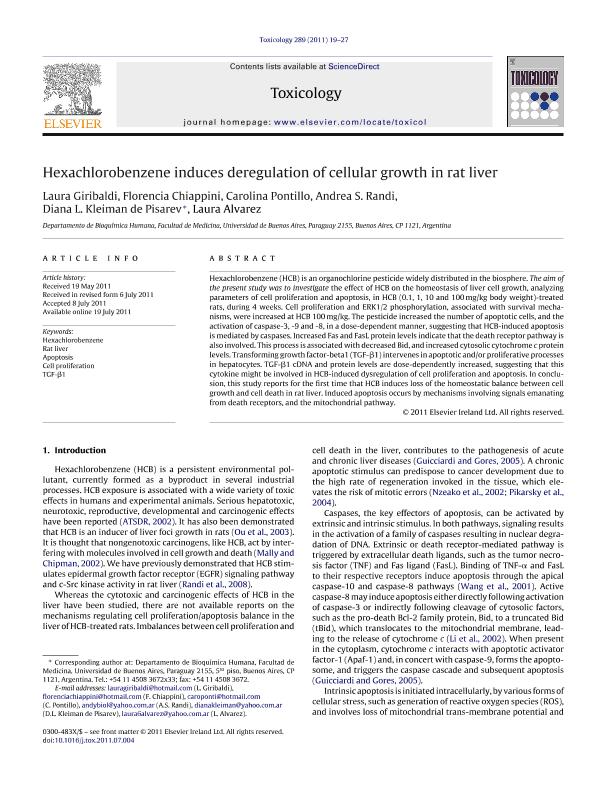Mostrar el registro sencillo del ítem
dc.contributor.author
Giribaldi, María Laura

dc.contributor.author
Chiappini, Florencia Ana

dc.contributor.author
Pontillo, Carolina Andrea

dc.contributor.author
Randi, Andrea Silvana

dc.contributor.author
Kleiman, Diana Leonor

dc.contributor.author
Alvarez, Laura

dc.date.available
2020-09-07T15:05:24Z
dc.date.issued
2011-10
dc.identifier.citation
Giribaldi, María Laura; Chiappini, Florencia Ana; Pontillo, Carolina Andrea; Randi, Andrea Silvana; Kleiman, Diana Leonor; et al.; Hexachlorobenzene Induces Deregulation of Cellular Growth in Rat Liver; Elsevier Ireland; Toxicology; 289; 1; 10-2011; 19-27
dc.identifier.issn
0300-483X
dc.identifier.uri
http://hdl.handle.net/11336/113334
dc.description.abstract
Hexachlorobenzene (HCB) is an organochlorine pesticide widely distributed in the biosphere. The aim of the present study was to investigate the effect of HCB on the homeostasis of liver cell growth, analyzing parameters of cell proliferation and apoptosis, in HCB (0.1, 1, 10 and 100. mg/kg body weight)-treated rats, during 4 weeks. Cell proliferation and ERK1/2 phosphorylation, associated with survival mechanisms, were increased at HCB 100. mg/kg. The pesticide increased the number of apoptotic cells, and the activation of caspase-3, -9 and -8, in a dose-dependent manner, suggesting that HCB-induced apoptosis is mediated by caspases. Increased Fas and FasL protein levels indicate that the death receptor pathway is also involved. This process is associated with decreased Bid, and increased cytosolic cytochrome c protein levels. Transforming growth factor-beta1 (TGF-β1) intervenes in apoptotic and/or proliferative processes in hepatocytes. TGF-β1 cDNA and protein levels are dose-dependently increased, suggesting that this cytokine might be involved in HCB-induced dysregulation of cell proliferation and apoptosis. In conclusion, this study reports for the first time that HCB induces loss of the homeostatic balance between cell growth and cell death in rat liver. Induced apoptosis occurs by mechanisms involving signals emanating from death receptors, and the mitochondrial pathway.
dc.format
application/pdf
dc.language.iso
eng
dc.publisher
Elsevier Ireland

dc.rights
info:eu-repo/semantics/openAccess
dc.rights.uri
https://creativecommons.org/licenses/by-nc-sa/2.5/ar/
dc.subject
APOPTOSIS
dc.subject
CELL PROLIFERATION
dc.subject
HEXACHLOROBENZENE
dc.subject
RAT LIVER
dc.subject
TGF-Β1
dc.subject.classification
Otras Ciencias de la Salud

dc.subject.classification
Ciencias de la Salud

dc.subject.classification
CIENCIAS MÉDICAS Y DE LA SALUD

dc.title
Hexachlorobenzene Induces Deregulation of Cellular Growth in Rat Liver
dc.type
info:eu-repo/semantics/article
dc.type
info:ar-repo/semantics/artículo
dc.type
info:eu-repo/semantics/publishedVersion
dc.date.updated
2020-09-03T16:58:29Z
dc.journal.volume
289
dc.journal.number
1
dc.journal.pagination
19-27
dc.journal.pais
Irlanda

dc.description.fil
Fil: Giribaldi, María Laura. Universidad de Buenos Aires. Facultad de Medicina. Departamento de Bioquímica; Argentina. Consejo Nacional de Investigaciones Científicas y Técnicas; Argentina
dc.description.fil
Fil: Chiappini, Florencia Ana. Universidad de Buenos Aires. Facultad de Medicina. Departamento de Bioquímica; Argentina. Consejo Nacional de Investigaciones Científicas y Técnicas; Argentina
dc.description.fil
Fil: Pontillo, Carolina Andrea. Consejo Nacional de Investigaciones Científicas y Técnicas; Argentina. Universidad de Buenos Aires. Facultad de Medicina. Departamento de Bioquímica; Argentina
dc.description.fil
Fil: Randi, Andrea Silvana. Consejo Nacional de Investigaciones Científicas y Técnicas; Argentina. Universidad de Buenos Aires. Facultad de Medicina. Departamento de Bioquímica; Argentina
dc.description.fil
Fil: Kleiman, Diana Leonor. Universidad de Buenos Aires. Facultad de Medicina. Departamento de Bioquímica; Argentina. Consejo Nacional de Investigaciones Científicas y Técnicas; Argentina
dc.description.fil
Fil: Alvarez, Laura. Consejo Nacional de Investigaciones Científicas y Técnicas; Argentina. Universidad de Buenos Aires. Facultad de Medicina. Departamento de Bioquímica; Argentina
dc.journal.title
Toxicology

dc.relation.alternativeid
info:eu-repo/semantics/altIdentifier/url/https://www.sciencedirect.com/science/article/abs/pii/S0300483X11002642
dc.relation.alternativeid
info:eu-repo/semantics/altIdentifier/doi/http://dx.doi.org/10.1016/j.tox.2011.07.004
Archivos asociados
